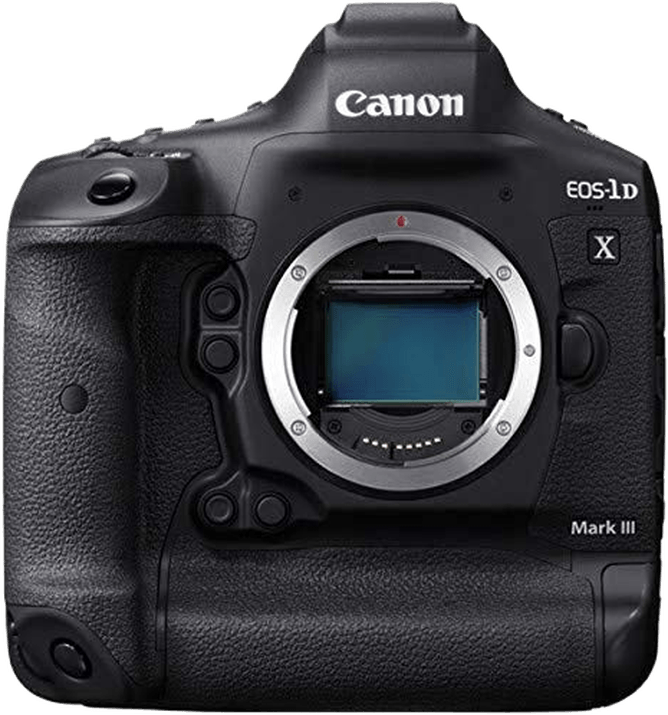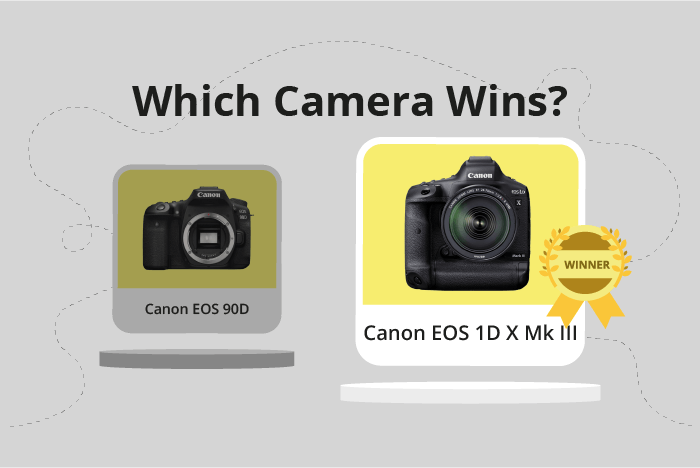Canon EOS 90D vs EOS 1D X Mark III Comparison
Canon EOS 90D

Canon EOS 1D X Mark III

Canon EOS 90D vs EOS 1D X Mark III Overview and Optics
The Canon EOS 1D X Mark III outperforms the Canon EOS 90D in optics, scoring 74/100 compared to the 90D’s 62/100. Both cameras share several specifications, including CMOS sensors, Canon EF lens mounts, and a lack of image stabilization.
The 1D X Mark III excels with its Digic X processor, 20 shooting speed, and a DXOMARK sensor score of 91. The advanced processor contributes to faster performance, while the higher shooting speed enables capturing fast-moving subjects more effectively. The impressive DXOMARK score indicates superior image quality and low-light performance, thanks to its full-frame sensor size.
On the other hand, the EOS 90D has a higher megapixel count at 33, allowing for more detailed images. However, its shooting speed is only 10, and the Digic 8 processor is not as advanced as the 1D X Mark III’s. Additionally, the 90D’s DXOMARK sensor score is lower at 58, and its APS-C sensor size is smaller, which may result in poorer low-light performance.
Despite the 90D’s advantage in megapixels, the 1D X Mark III’s superior performance in other areas, such as shooting speed, processor, and sensor size, make it the better choice for optics. The full-frame sensor and higher DXOMARK score ensure better overall image quality. However, if high-resolution images are the primary concern, the 90D may be a suitable option.
Ultimately, the Canon EOS 1D X Mark III is the clear winner in optics, providing better performance and image quality. The Canon EOS 90D, while offering higher resolution, falls short in other crucial aspects, making it the less desirable choice for those prioritizing optics.
Canon EOS 90D vs EOS 1D X Mark III Video Performance
The Canon EOS 90D and the Canon EOS 1D X Mark III both have a video score of 91/100, indicating that they share similar video capabilities. Both cameras offer 4K video resolution, with the 90D providing a maximum video dimension of 3840 x 2160, while the 1D X Mark III has a slightly larger maximum dimension of 4096 x 2160. Both cameras can also record video at a maximum frame rate of 120fps and have built-in time-lapse functionality.
Despite having the same video score, the 1D X Mark III has an advantage in its larger maximum video dimensions. This means it can capture more details and produce a slightly higher quality video than the 90D. The 1D X Mark III is better in this aspect.
However, the Canon EOS 90D has its own strengths. While both cameras offer 4K video resolution and a 120fps frame rate, the 90D is generally a more affordable option for those who do not require the additional features found in the 1D X Mark III. The 90D is better in terms of cost-effectiveness.
Both the Canon EOS 90D and the Canon EOS 1D X Mark III have strong video capabilities, with the 1D X Mark III having a slight edge in maximum video dimensions. The 90D, on the other hand, offers a more budget-friendly option for those who do not need the extra features of the 1D X Mark III. The choice between these two cameras ultimately depends on the specific needs and budget of the user.
Canon EOS 90D vs EOS 1D X Mark III Features and Benefits
The Canon EOS 90D outperforms the Canon EOS 1D X Mark III in features, with a score of 83/100 compared to 74/100. Both cameras share some specifications, such as touchscreen capabilities and WIFI connectivity. However, each camera has its unique strengths and weaknesses.
The EOS 90D is superior in several aspects. It has a flip screen, which allows for more versatile shooting angles and is beneficial for vloggers and content creators. Additionally, the 90D includes Bluetooth connectivity, providing an extra option for transferring files and remote control.
On the other hand, the EOS 1D X Mark III has its advantages. Its screen size is slightly larger at 3.2 inches, compared to the 3-inch screen on the 90D. Furthermore, the 1D X Mark III boasts a higher screen resolution of 2,100,000 dots, ensuring a clearer and more detailed image preview. This camera also features GPS functionality, which is useful for geotagging photos and tracking the location of shoots.
Despite the higher feature score of the EOS 90D, the EOS 1D X Mark III holds its ground with a larger and higher-resolution screen and GPS capabilities. However, the 90D’s flip screen and Bluetooth connectivity make it a more versatile option for various shooting scenarios. When considering which camera to choose, photographers should weigh the importance of these specific features for their individual needs and preferences.
Canon EOS 90D vs EOS 1D X Mark III Storage and Battery
The Canon EOS 1D X Mark III outperforms the Canon EOS 90D in storage and battery, scoring 87/100 compared to the 90D’s 48/100. Both cameras lack USB charging capabilities. However, the 1D X Mark III has a significant advantage with its two memory card slots and compatibility with CFexpress Type B cards, whereas the 90D only has one slot, accepting SD, SDHC, and SDXC cards.
Moreover, the 1D X Mark III boasts a remarkable battery life of 2850 shots, using the LP-E19 battery type. The 90D falls short with 1300 shots using the LP-E6N battery. This difference makes the 1D X Mark III superior in terms of battery performance.
The 90D does have one advantage, though: it supports UHS-II cards, which are widely available and affordable. Despite this, the 1D X Mark III remains the better camera for storage and battery capabilities. This superiority in storage options and battery life make it the clear winner in this comparison.
Canon EOS 90D vs EOS 1D X Mark III – Our Verdict
Are you still undecided about which camera is right for you? Have a look at these popular comparisons that feature the Canon EOS 90D or the Canon EOS 1D X Mark III:

